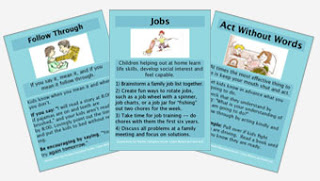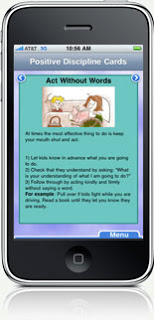I am so excited to finally share this with you… Definitely my ABSOLUTE FAVORITE workshop at the International Nanny Association Conference in May 2010. I attended the workshop on Positive Discipline by Certified Positive Discipline Trainer, Susan Lehman, and became intrigued with the philosophy and methods. While much of this was familiar to me as a Nanny, I enjoyed seeking the details formalized and structured along with examples of each. I feel these tools are a great benefit for Nannies and parents, and can be tailored to the unique-ness of each child.

Positive Discipline is a program designed to teach young people to become responsible, respectful and resourceful members of their communities. Based on the best selling Positive Discipline books by Dr. Jane Nelsen and co-authors Lynn Lott, Cheryl Erwin, Kate Ortolano, Mary Hughes, Mike Brock, Lisa Larson and others, it teaches important social and life skills in a manner that is deeply respectful and encouraging for both children and adults (including parents, teachers, childcare providers, youth workers, and others).
Recent research tells us that children are “hardwired” from birth to connect with others, and that children who feel a sense of connection to their community, family, and school are less likely to misbehave. To be successful, contributing members of their community, children must learn necessary social and life skills. Positive Discipline is based on the understanding that discipline must be taught and that discipline teaches.
Jane Nelsen gives the following criteria for “effective discipline that teaches”:
FIVE CRITERIA FOR EFFECTIVE DISCIPLINE
- Helps children feel a sense of connection. (Belonging and significance)
- Is mutually respectful and encouraging. (Kind and firm at the same time.)
- Is effective long – term. (Considers what the child is thinking, feeling, learning, and deciding about himself and his world – and what to do in the future to survive or to thrive.)
- Teaches important social and life skills . (Respect, concern for others, problem solving, and cooperation as well as the skills to contribute to the home, school or larger community.)
- Invites children to discover how capable they are. (Econstructive use of personal power and autonomy.
- “You look sad. Did you get hurt?”
- “I can see that you are mad when you throw that toy. But I want to be safe, so lets hit this pillow instead”
- “That was scary, huh?”
- “You are really angry that you have to go now, but it is not OK to hit me because it hurts (rub where you were hit and make a sad face to show it hurts)
- “You really liked when he did that!”
- Young children like to “dump” things out. Then this happens you can clean up together in a fun way and they will most likely jump right in to help.
- Show your child how to treat the family cat by petting the kitty and saying “Gentle, gentle, with the kitty.”
- Bend down, get eye to eye, while holding his or her hands and say what you want to tell him or her.
- “That must have hurt. You are really sad that you bumped your head.”
- “It looks like you need to calm down. Let’s go take a break together.” (When a child is starting to calm down and can listen to you, you could read a book, listen to music or something else calming so they start to learn calming skills.)
- “You grabbed my glasses. I don’t like that. Can you help me put them back on?”
- “The milk sure spilt all over the place. Let’s get some rags to wipe it up together.”
- “When you hit your sister, it hurts her. Let’s go see if she’s OK.”




How cool that you nanny for triplets too! These are my 6th set….love multiples! “Mine” are BBG and just turned 3 the end of April. I’ve was hired a few months before they were born and was able to be there from the beginning starting with day 1 in the NICU. Feel very lucky to have such a great history with this family!
I’d love to exchang stories with you if you were interested. Please feel free to email me, or check out some of my fun with ‘my’ triplets on my blog 🙂
Cori
[email protected]
What a nice review. I have asked my webmaster to put a link to your blog on my website under news and events. Thanks,
Greta, You might introduce your readers to the Positive Discipline Social Networking site at http://www.positivediscipline.ning.com There are lots of trainers and parents and caregivers from all over the world sharing their experience (and questions) with these tools. There is even a group for nannies that Susan Lehman started. I’m sure you would be welcomed!
Jody McVittie, MD
Positive Discipline Lead Trainer
Thank you for your feedback Greta! I presented Navigating the Teenage Years with Positive Discipline at the same conference. Susan and I were delighted by the interest and response.
We are planning a 2 day training for Nannies in Feb or Mar 2011, probably in LA or San Francisco.
Jane Weed-Pomerantz
Santa Cruz, CA
This is great – I love hearing that Nannies are just as interested in growing responsibility, confidence, and capability in the children they care for. Having worked in the Child Care industry for over 40+ years myself, i think Positive Discipline is a life-saver to caregivers. And Susan and I share the same passion for reaching all who connect with young children. Congratulations on becoming the only SUPERNANNY I’d EVER RECOMMEND! Love hearing the cudos for your work, Susan! Much Joy, Mary Hughes, Certified Positive Discipline Lead Trainer, Bellevue, Nebraska
Hi, Greta! I’m thrilled that you were able to glean so much out of the workshop! And I see you’re using the Tool Cards! Just a side note- I’m not a Ph.D., I’m a CPDT- Certified Positive Discipline Trainer.
I hope to see you next year! love, Susan
Thanks everyone for your feedback. We are looking to do a workshop here in Cincinnati. Are there any trainers near us?
Thanks for the Ning link, I will share that!
I really enjoyed this at the INA Conference, though I have used some of the methods before, I am glad to have so many more “tools” for my nanny tool belt. With triplets it can be very difficult at times. I have a lot more confidence about methods now. I also have a solid technique(s) to pass on to parents and other nannies.
Thanks again 🙂
This comment has been removed by the author.
Early childhood education